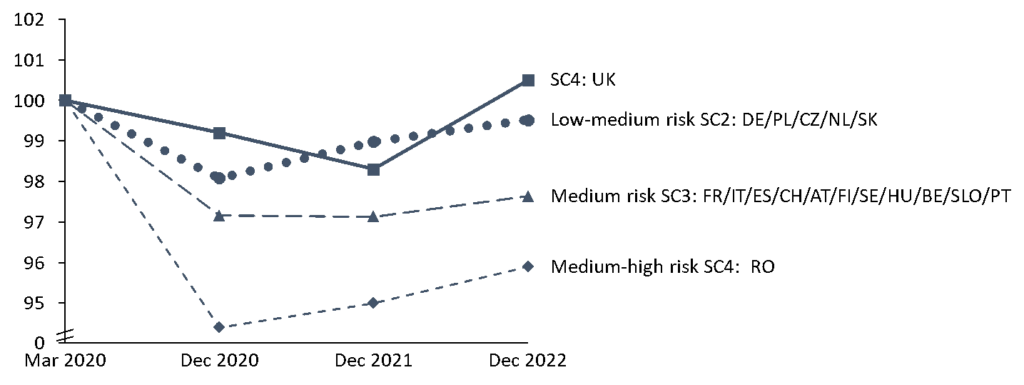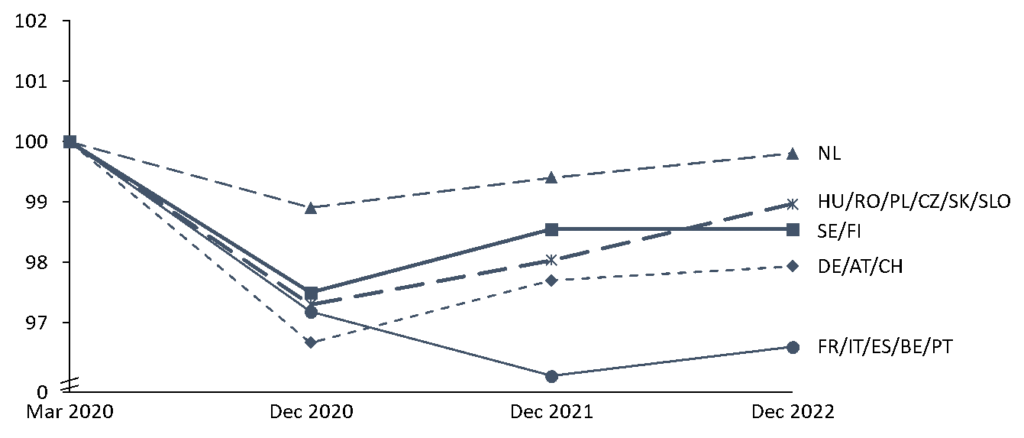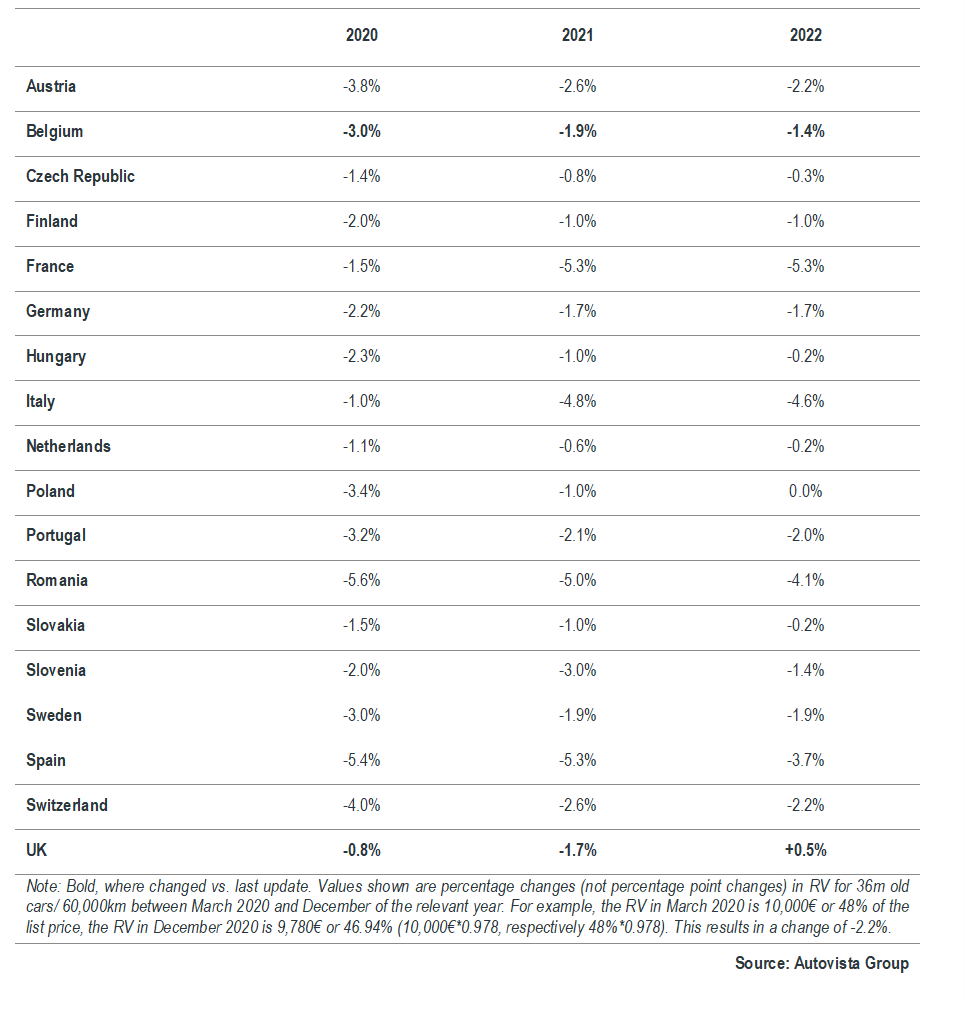How will COVID-19 shape used-car markets – June 2020 update
09 June 2020

The June update of Autovista Group’s whitepaper: How will COVID-19 shape used-car markets? considers the ongoing impact of COVID-19 across Europe.
€2.6 billion of economic losses for dealers in Europe
We have reported on the grinding halt of the automotive industry and the impact of the lockdown in several stories and podcasts over the past weeks.
The industry is now slowly emerging from the pandemic lockdown in many markets. After Austria, Germany entered the ramp-up phase and others are following. These steps, even if they feel small, are crucial, as industry needs to progress to a new normal. The main reason is that economic losses, which have been building up, are tremendous. For dealers in Europe the losses have almost doubled since our last analysis 30 days ago from €1.7 billion to €2.6 billion for their used car operations alone during the lockdown, not taking into account possible losses in the ramp up phase.
In Table 1, we have laid out the mechanics for this estimate. There are three elements to the calculation.

Firstly, there are – albeit currently small – losses in residual values (RVs) across all markets for the period of the lockdown. We expect them to continue to build up over the coming weeks and months and have laid out our scenarios later in this whitepaper.
The main reason for the pressure on RVs is the developing economic crisis. Latest forecasts estimate economies in Europe could contract by 7% or potentially more in 2020. Forecast institutes do not anticipate a quick economic recovery and this will wash through to purchasing power and private demand.
We also see a more negative development of used car prices in countries that have had no or a more relaxed lockdown but more exposure to the economic impact of the crisis.
Used car values in Sweden, which did not enforce a lockdown, and in Finland and the Netherlands, where dealers remained open over the past weeks, show a bigger decline in RVs than those markets that were largely closed, e.g. France, Germany and the UK (Figure 1). The economic pressure to reduce prices may outweigh any benefits from pent-up demand and shortage of new car supply.
Secondly, stock days rise during lockdowns and each day costs money, in particular associated to lending. We estimate that these costs are around €10 per day of lockdown. Figure 2 demonstrates how sharply days in stock of active adverts increased during the lockdowns. Meantime in Finland and Sweden, the no-lockdown markets, there had been a rise in days in stock that washed through to lower residual values.
Thirdly, we estimated the loss in value due to the ageing of the individual vehicle. These costs come on top of the cost incurred due to capital employed.
Figure 1: Used car price index for selected markets

Source: Autovista Group, Residual Value Intelligence (RVi), COVID-19 tracker
Figure 2: Days in stock of active adverts

Note: Finland (pink). Germany (black). Spain (yellow). Sweden (green). UK (red). Source: Autovista Group, Residual Value Intelligence (RVi), COVID-19 tracker
Fending off coronavirus – measures post lockdown
As markets begin to ease out of lockdowns, setbacks are emerging during the ramp-up phase. Ford had to close its Chicago assembly plant twice in less than 25 hours as two workers tested positive for Covid-19. There are more cases like these. It is no surprise that the European Automobile Manufacturers Association ACEA has published 25 actions for a successful restart of the EU’s automotive sector. Recommendation No. 1: “Issue harmonised guidance on health and safety precautions for the workplace”. This is imperative as employers are responsible for the well-being of their staff.
Besides a thorough assessment of the supply chains and a re-start of cross-border logistics, another topic resurfaces – “vehicle renewal schemes for all vehicle categories”. Many agree that the automotive industry requires a stimulus package but there is ongoing debate in many markets about what shape a scheme should take. The uncertainties around such a stimulus package currently reduces customer willingness to buy a car.
Pressure continues to rise on dealers to turn stock, as inventory ages. Stimulus packages do not only support OEMs but dealers who will be under more stress than before. For dealers it will be pivotal to avoid giving in to the temptations of discounting. “Our advice is to reduce exposure to cars and model years that had been difficult to sell in normal times and focus on high-quality used vehicles and stick to price for those,” says Dr Christof Engelskirchen, Chief Economist of Autovista Group. Patience will be required as we see that activities at dealers are not at the pre-lockdown level. There is still 40% less activity in new used car advertisements in Austria and Germany, weeks after the lockdown has ended, as dealers are still working on lowering stock levels.
Digitally enabled buying
One of the most annoying things when shopping for a car is the haggling for the best price. The expectation of many customers is that the price published on a web portal or the dealer website is a ballpark figure. Savvy buyers shop visiting again later. This strategy was time-consuming before the pandemic. Now it is excessively so. Dealers will not be able to sell like this. We now need more efficient, digitally enabled shopping experiences.
Leasing, financing and other benefits
It is likely that we will see some pent-up demand over the coming weeks, but it is also possible that consumers could be reluctant when it comes to making longer-term financial commitments like those associated with a traditional vehicle purchase. There are powerful and smart ways to avoid highlighting discounts: dealers should focus their attention on offering excellent leasing and financing conditions. Discounts can be incorporated via free service components, 0% financing, no down-payments or delaying the first instalment by several months. There may be other impactful ways for dealers to offer a benefit without talking discounts, e.g. an extended right to cancel the contract or shortened leasing periods.
Used car leasing and car subscriptions
In periods of economic uncertainty, flexibility is key. Long-term financial commitments are challenging to obtain. We are already seeing a surge in demand for used car leasing and subscription models, and there are several start-ups and incumbents in this line of business. These business models, if dealers adopt them, would help soften the crisis during this transitional period. Individually, dealers and dealer groups can think about creating attractive offers for smaller businesses and fleets. What is a company with five to 10 company cars looking for? How can you offer financial flexibility to these businesses?
E-commerce as a response to an anticipated second wave of the pandemic
The coronavirus pandemic has painfully proven that the lack of digitisation of the automotive sales and marketing value chain is a burden that the industry must overcome. In the absence of access to shops and dealers, customers have focused their attention on e-commerce. An omnichannel strategy will be more resilient than other single-channel strategies in the future.
“It is beneficial to look at markets like the Netherlands or the Nordics and see what can be copied. They are more active in the digital space. This will be crucial not only when considering a possible second or third wave of the pandemic,” claims Roland Strilka, Director of Valuations at Autovista Group.
Dealers need to work on an inclusive strategy, which conserves the achievements of physical reach and network coverage. Both are crucial ingredients for addressing customer needs, irrespective of the business model.
Mergers and partnerships
Mergers and partnerships continue during the crisis, e.g. the FCA-PSA merger is on course for completion before the end of Q1 2021. But there is always a risk that stakeholders fear that the valuation will differ post Covid-19. So far, share prices are down 45% for both companies. Meantime VW and Ford are moving ahead with technology sharing around electric and self-driving to save costs.
Coronavirus scenarios – how swiftly will economies recover?
In our ambition to support analysis of the impact of the coronavirus on the automotive industry, we have developed a number of scenarios. The scenarios are based on risks associated with the following five mandatory parameters, as well as other country-specific factors that influence RV development:
- How long until the spread of infections is contained;
- The economic outlook for 2020, 2021 and 2022;
- On the supply side, expected issues in the supply chain for new car production;
- On the demand side, development of private consumption over the coming years; and
- An assessment of how effectively fiscal and monetary policy measures are working.
Views on the economy darken
Since the publication of the previous version of this report in early May 2020, the view of the crisis and its economic impact has darkened. Before the lockdown, forecasts of GDP growth were around 2% for 2020 globally and slightly below 1% in the Eurozone – an outlook that had already been depressed compared to January and February baselines.
Over recent months, economic forecasts have been declining. They continue to decline but more gradually over the past 30 days than during the months before. They seem to be bottoming out at low levels.
For Global GDP development Moody’s has reduced their outlook from -2.4% for 2020 to
-4.5%. The IMF is slightly more positive, other institutes are more negative. “Existing statistical models fail to provide consistent economic forecasts under the current conditions, in particular due the unknown impact of the many variables around the pandemic,” according to Christof Engelskirchen. One of the biggest economic concerns relates to a second or third wave of the pandemic, which could have a lasting impact on consumer spending. The re-emerging conflict between China and the US may create further economic pressure.
Stock markets on the other hand are more positive in assessing the current situation. They look beyond this and next year towards the longer-term earning potentials but are susceptible to volatile swings should more news that is negative, re-emerge.
For the Eurozone, Moody’s now expects a contraction of around 7% in 2020, instead of -6.5% at our last update, and a substantial but still only partial recovery in 2021 (+4.8%). The IMF forecasts at similar levels, -7.5% in 2020, in their April assessment. Forecasts for the UK are similar to those for the Eurozone, i.e.
-7.4% in 2020 and +5.4% in 2021 according to Moody’s.
There are worse scenarios than these, but all research institutes signal that forecasts are just ballpark estimates at this stage. There is too much uncertainty around how big and long a post-pandemic economic crisis might be.
Governments and authorities, such as France and the EU, have put a lot of emphasis on lifting bans on manufacturing and returning as many people as possible back to work. Tourism, travel, leisure and events will continue to be affected. There is a likelihood that this will have a more sustained effect on the demand side and private consumption. That is why we could expect a w-type recovery, i.e. a second dip towards the end of the year after a temporary recovery phase in Q3 brought on by the release of pent-up demand. Whether this ‘w’ will be very pronounced, depends a lot on how successful the current infection containment measures prove to be. The only true solution would be a breakthrough in the quest for a vaccine or an effective treatment.
In this update, we have included an additional five countries, the Czech Republic, the Netherlands, Portugal, Slovakia, and Slovenia. This brings our total coverage to 18 countries.
Most likely scenario: ‘Medium Risk’
Most markets have confirmed their expected risk scenario. After the addition of five more markets 11 out of 18 markets assign the highest risk to Scenario 3, ‘Medium risk scenario: slow u-shaped recovery’. Italy, Spain, France, Austria, Switzerland, Sweden and Finland said their assessment and probabilities align with this scenario (see Table 2).
Portugal and Slovenia, which were added in this update, put forward the medium risk scenario. According to João Areal, Editorial Manager at Autovista Eurotax Portugal: “Almost 1 million employees are in furlough or have been laid off, resulting in a severe reduction in salaries. The recession will be longer, and recovery will not be v-shaped but u-shaped.”
Hungary has confirmed Scenario 3, but it has upped the likelihood of Scenario 2 from 20% to 40%, resulting in equal probabilities for these two scenarios. Zsolt Horvath, Operations Manager, Eurotax Hungary explained: “Hungary has been in ramp-up since the third week of May. A key factor for the future is the expected weak Forint against the Euro, which will put pressure on new car sales. In the best-case scenario, new car sales will drop by 20-25%. Pressure on used car prices may be lower than initially expected.”
Belgium also confirmed Scenario 3 but lowered the outlook and increased the probabilities of the more negative scenarios. Our editorial team have reduced the likelihood of a Scenario 2 – ‘moderately quick v-shaped recovery’ – from 35% to 10%. Instead, a Scenario 4 likelihood rises to 30% from 10%. “We see the pressure on prices building up. Dealerships only opened at the end of May. We expect a drop in new car sales activities by around 20% in 2020, with the latest projections targeting 450,000 registrations in 2020 vs. 550,000 in 2019,” according to Idesbald Vanniewenhuyze, Executive Chief Editor Benelux. “Belgium is highly dependent on economic revival from surrounded countries.”
Highest risk in Romania and UK
Romania and the UK present the most pessimistic outlooks in this line-up. 70% and 65%, respectively, are the probabilities for Scenario 4: ‘Deep recession slow recovery’. “Various institutes calculate the GDP drop for Romania in 2020 at between -6% and a rather disappointing -9%. More than 30% of Romania’s GDP comes from recreation, retail, food and accommodation and these sectors are most affected. The gradual relaxation of lockdown measures announced for June include reopening of restaurants as well as announcing new measures that allow summer tourism to take place, albeit under stricter rules than usual,” says Ulmis Horchidan, Chief Editor at Autovista Romania.
The UK confirmed its scenario but has become slightly more negative in its assessment during this update. It is the only country that is currently allocating a substantial risk of 35% to our Scenario 5: ‘Very deep recession, l-shaped recovery’. The combination of the negative economic consequences of the pandemic and Brexit are behind this gloomy outlook. Anthony Machin, Head of Content and Product, Glass’s said: “Increasing redundancies in parallel to the entry into a likely severe recession is starting to wobble the British people’s resolve. Dealers in England re-opened from 1 June but demand for used cars will take longer to recover than initially forecast.”
V-shaped recovery still possible?
Not every market will be equally affected, and some may be able to recover more swiftly. Poland confirmed, even marginally improved, its view that it may emerge out of the crisis more successfully than many other markets in Europe. “Market participants have been active in preparing special programmes to support demand. After a bigger decrease of demand in March and April, we should expect a phase of recovery.” according to Marcin Kardas, Head of the Editorial Team at Autovista Polska. “The Polish market is strongly focused on used cars. There are over 1 million imported used vehicles from abroad in comparison to 550,000 new vehicles sold last year.”
Germany has started a ramp-up phase, so far with moderate success. Head of Valuations & Insights at Schwacke, Andreas Geilenbrügge, confirmed last month’s outlook but added: “The reopening of dealers in the past weeks have caused a lot of activity for dealerships. There are more removed adverts than added ones in the most important age groups due to the lack of supply. However, demand has not fully recovered. The discussions around a state-funded economy stimulus package appear be resolved, amounting to €130 bn overall, and needs to be passed by parliament. ‘Green car’ incentives will be increased, and VAT lowered. We will review our RV forecasts during June/July.”
Amongst the new additions to this update, the Netherlands have attributed 65% to Scenario 2, the Czech Republic and Slovakia each 50%. The Dutch market, according to Nico Vanhalst, RV Manager, Eurotax Nederland “has been transforming into a market with many electric vehicles. There is still too little supply and thus less pressure on RVs. In addition, the sale of electric vehicles (new and used) will be financially supported from 1 July 2020 with an incentive. This amounts to €4,000 for new cars; €2,000 for used cars.”
Slovakia and the Czech Republic are both highly dynamic and resilient markets. “In Slovakia, the demand for used cars is increasing. The Czech Crown exchange rate fell by almost 10% against the EUR. We should see some ability to absorb used car supply,” says Horvath.
Table 2: Risk scenarios for the impact of coronavirus

Impact on residual values
The impact on residual values depends on the most probable scenario and country-specific circumstances. Figure 3 shows the residual value development by scenario cluster, unweighted and indexed. Countries have been allocated to the scenario cluster according to their highest-probability scenario. The more optimistic views in Poland, Germany, Slovakia, the Netherlands and the Czech Republic anticipate a more moderate decline in RVs of around 2% towards the end of 2020 and then a relatively swift recovery.
The majority of countries assign a higher probability to the medium risk scenario, which describes a drop in RVs that may extend beyond the end of 2020 and a prolonged recovery phase. Towards the end of 2022, used cars will – on average – still trade around 3% lower than in March 2020.
Romania, confirming a more pessimistic view in this update, anticipates a steeper drop towards the end of 2020 – by more than 5% – and no full recovery by end of 2022.
The outlook for the UK, in line with its darker view on the economic situation, sees a drop by 2% towards the end of 2021 vs. March 2020 levels but a swifter recovery beyond. By the end of 2022, the UK will have fully recovered in terms of used car prices to levels above those in March 2020. The main reason is the limited elasticity in the market, together with the fact that supply of new cars has drastically reduced and is unlikely to ramp up again soon. The expectation is a continued supply shortage during the economic downturn.
Sorted by country cluster (Figure 4), it becomes apparent that Southern Europe, including France and Belgium, will be impacted the longest and anticipate the worst impact.
In Austria, Germany and Switzerland, we see a quicker recovery, but this is driven in particular by the more optimistic view for Germany.
The Eastern European cluster, consisting of Hungary, Romania, Poland, the Czech Republic, Slovakia and Slovenia, shows a more elastic development.
The Nordic region, represented by Sweden and Finland, is most elastic in its recovery but to lower levels until 2022. “Towards the end of March and beginning of April we could observe drops in the used car prices in Sweden and Finland and growing stock levels at dealerships. Around the end of April and beginning of May the prices stabilised,” according to Johan Trus, Head of Data and Valuations Nordics at Autovista. “The lower new car registrations and the weak Swedish currency are two factors that will help to keep used car prices from dropping more in the near future.”
Figure 3: Used car price development by scenario cluster; UK separated out (indexed)

Note: These clusters represent unweighted averages of countries and do not represent country-specific forecasts. Please refer to Table 3 for the country-specific forecasts. Source: Autovista Group
Figure 4: Used car price development by regional cluster (indexed)

Note: These clusters represent unweighted averages of countries and do not represent country-specific forecasts. Please refer to Table 3 for the country-specific forecasts. Source: Autovista Group
France and Italy expect the biggest hit on used car values to occur in 2021, after a more moderate decline in 2020 (France -1.5%; Italy -1.0%). Both expect the supply shortage of new cars to soften the blow. The full effect of the crisis should be visible during 2021. Italy has been particularly exposed to the coronavirus pandemic, turning into a full-blown economic crisis that will affect private demand for used cars for a longer period. Italy confirms its assessment vs. the previous update of this whitepaper.
France has also confirmed its outlook for RV impact for this update, but it is important to mention that the outlook for France does not include the latest announcement on a vehicle stimulus package by the French government, which will put used car prices under pressure. Yoann Taitz, Operations and Valuations Director, Autovista France said: “Covid-19 has been an accelerator of the crisis the automotive industry is currently experiencing as the situation already began to deteriorate some months ago, and it especially declined as of January 2020 after tax and regulation changes.”
For Austria and Switzerland, we expect the biggest impact on RVs still in 2020 owing to the scenario chosen. Almost three years into the economic crisis, by the end of 2022, residual values will still trade on average 2% lower than in March 2020. Robert Madas, Valuations and Insights Manager for the two markets comments: “Austria’s economy has already been hit hard by the crisis with an all-time high in unemployment (12.8% or almost 600,000 people). Additionally, there are around one million people in reduced hours work with a reduction in salaries. Thus, we expect a significant drop in private demand for new cars, as well as for used cars. In Switzerland, the impact has not been as severe. However, we expect less pent-up demand as online sales and car registrations were possible even during the lockdown. In both countries we already see a drop in used car prices and expect further impact on RVs because of higher economic pressure on dealers during the coming months.”
For Belgium, we expect a downwards correction by the end of 2020 of 3% on average. Used car prices will stabilise around 1.9% lower than March 2020 levels in 2021 and remain at a slightly depressed level in 2022. “These are the anticipated average changes but there are substantial differences to be expected between segments,” according to Idesbald Vanniewenhuyze.
“Different factors are at play here. The taxation scheme change planned in January 2021 will support the switch to a new car. Therefore, young used cars up to 24 months in age should suffer more. Discounts offered during the January 2020 Brussels Motor Show have put additional pressure on prices as well as first observed high discounts in other countries. A decline of used car prices abroad will impact us. For older vehicles over 36 months, we should see a lower market correction. For €5-4 even a stabilisation, as they remain important ‘budget’ alternatives.”
Table 3: Forecast percentage change in residual values EoY vs. March 2020

Germany sees the biggest drop in RVs occurring in 2020 (-2.2%). There will be a small recovery in 2021 and then RVs will stabilise in 2022 at a level down by 1.7% compared to March 2020 values. The expectation is that Germany will come out of the crisis more swiftly as private consumption will support the economy.
These forecasts do not reflect the currently ongoing discussions around a state-funded vehicle replacement scheme, which will likely increase the pressure on used vehicles.
Spain has also confirmed its more negative view on used car market development. Spain expects to see a substantial drop in 2020 of 5.4% compared to March 2020 values and that drop will remain stable in 2021. Even in 2022, residual values will not have fully recovered (-3.7% by then end of 2022 compared to March 2020). One of the main reasons is the very strong RV performance in Spain during the past few years. The downward correction will therefore be more pronounced and continue for a longer period despite the expected economic recovery. There are discussions around a vehicle replacement scheme as well.
According to Ana Azofra, Valuation & Insights Manager at Autovista Spain, “In the absence of information on the incentives that could be implemented, manufacturers put pressure on the market and release the stock through discount activities.
This will have short- and medium-term impact on RVs. We have also started to observe a negative trend in used car published prices, which we will be able to gauge and confirm as the number of transactions increases.”
Conclusion
This is the second update to our analysis of the impact that the coronavirus will have on societies, the economy and used-car markets. This update now includes 18 markets.
The impact of the economic crisis on RVs will be felt differently depending the circumstances in individual countries. Autovista Group expects a sharper drop in RVs in the Southern European countries, in some around 5-6% at the peak of the crisis. In Austria, Germany, the Netherlands, Switzerland and the Nordics, the regions will not be hit as hard, based on the current risk assessment. A more elastic recovery could be anticipated in Eastern Europe, in particular the Czech Republic, Poland and Slovakia.
During the 2008/2009 financial crisis, we saw falls in RVs that were substantially higher than currently forecast in our most probable scenarios. At the time, declines of 12% on average across segments built up over 12-18 months into the crisis.
We are currently far from expecting this level of impact on used car markets, as indicated in our risk scenario probabilities and RV forecasts.
Several things have now changed: Eurozone governments have taken much stronger policy actions against the collapsing demand, the current economic shock is not paired with a lack of financing opportunity and after the peak of the crisis, we should see some pent-up demand as private consumers perceive the shock as temporary.
There are some positive signs emerging. For example, ramp-up phases in Austria and Germany have been running smoothly so far. Moreover, the numbers of daily infections appear to be easing in the most affected European markets. However, the US, South America and many developing countries are at risk of easing the lockdown too fast and too early.
On the negative side, we observe emerging discussions around government-funded vehicle incentive schemes that will put pressure on used car prices.
We will continue to update this analysis on a monthly basis and see how assumptions and scenarios evolve and how quickly and extensively the used-car market adapts.
Author
- Dr. Christof Engelskirchen, Chief Economist, Autovista Group
Analysts and Contributors
- Hans-Peter Annen, Chief Editor, Autovista Switzerland
- João Areal, Editorial Manager, Autovista Eurotax Portugal
- Ana Azofra, Valuation and Insights Manager, Autovista Spain
- Dejan Butinar, Country Manager, Eurotax Slovenia
- Andreas Geilenbrügge, Head of Valuations and Insights, Schwacke (Germany)
- Ulmis Horchidan, Chief Editor, Eurotax Romania
- Zsolt Horvath, Operations Manager, Eurotax Hungary
- Marcin Kardas, Head of Editorial Team, Autovista Polska
- Anthony Machin, Head of Content and Product, Glass’s (UK)
- Robert Madas, Valuations and Insight Manager Austria & Switzerland, Eurotax
- Marco Pasquetti, Forecast and Data Specialist, Autovista Italy
- Yoann Taitz, Operations and Valuations Director, Autovista
- France Johan Trus, Head of Data and Valuations Nordics, Autovista
- Roland Strilka, Director of Valuations, Autovista Group
- Nico Vanhalst, RV Manager, Eurotax Nederland
- Idesbald Vannieuwenhuyze, Chief Editor and Valuations Manager, Autovista Benelux



